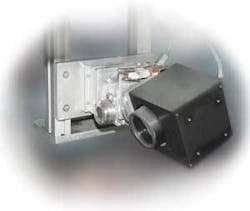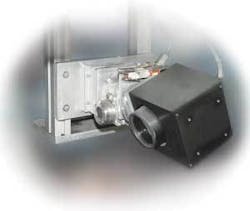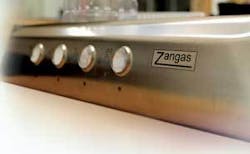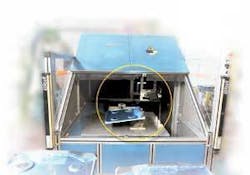Marking large areas
Laser marking finds a home on the (stove) rangE
Robin Barbero and Candida Colonna
Zanussi-Electrolux, a leading supplier of kitchen appliances in Europe, is the current name for the Zanussi Company, which was founded in 1916 by Antonio Zanussi who started the business by making home stoves. The company traces its heritage back to 1858 when it produced terracotta heaters. Located in the Northeastern Italian city of Pordenone, the company prospered as it developed a sales network and improved production to the point where it had 100 employees in a 3000m2 plant in 1936.
During that period Zanussi designed the AZP iron stove that became an international success. After World War II the company expanded the product line to include refrigerators and washing machines. In 1959 it entered the market for large commercial appliances for restaurants and factories by establishing the Grandi Implanti division. At this point the company had become the second largest supplier of home appliances to the Italian market.
The company acquired another Italian supplier, Zoppas, in 1970 and in 1984 it merged with the giant Swedish appliance maker Electrolux and became a division building kitchen and cleaning appliances under the Zanussi-Electrolux brand name. Since then the company has gained a reputation for unique, trend-setting products. So much so that it manufactures brand name labeled products for IKEA, Expert, and other international sales organizations.
Among the company’s products is a stainless steel electric or gas kitchen range which, by design, featured certain curved surfaces that required permanent marks, such as the logo, model numbers, graphics for on/off and temperature adjustment numbers, and for the brand name customer’s special markings. Zanussi was using conventional silk screening techniques to produce these marks but these did not meet mandated safety requirements for permanency as the marks did not stand up to cleaning by users who could, over time, wipe these marks away. Zanussi tried a number of paints and chemicals to solve this problem but none proved perfectly successful.
In 1995, Zanussi first approached several laser marking systems suppliers and chose the Italian supplier Lasit, which was able to define specific marking parameters that ultimately led to a turnkey laser marking solution. That company developed a “Pre-scan’ marking system with the beam from an 80-watt Nd:YAG laser-two galvanometers scanned a 35mm diameter beam coming from an adjustable focus optic system (Z-dynamic) that provided marking areas up to 500 x 500 mm with the same spot quality as that produced by conventional flat field devices that only offered a 100 x 100 mm marking area.
Basically the focusing system is behind the galvo mirrors while in a flat field lens system it is just after the mirrors. The lenses are designed in such a way that a small movement of the entrance lens (the smallest in diameter) results in a larger variation of the focusing distance. A linear stage, called the Z-dynamic, is used to fast move the lens according to the actual position of the X/Y steering mirrors. A DSP based electronic calculates, in real-time, the position of the lens controlling the movement of the Z-dynamic. By expanding the beam to 35 mm and then focusing it, a small spot size is produced even with a long focus distance. A small spot size is necessary to obtain high-contrast mark edges. The system enabled marking in areas up to 500 x 500 mm. And the device allowed compensation for part curvature because the focus position can be adjusted in real time by a computer program developed to control the focus on a curved surface. This became the solution for the Zanussi cooking range graphics problem, obtaining a permanent mark that, over time and with continual cleaning remains legible.
However, one problem remained: the stove plates were large, heavy (4-6 kg), and sharp edged. Plus the surface to be marked was typically angled in respect to the base of the plate. And in a typical day production ranges from 450 to 700 pieces per shift depending on stove type and artwork. So to ensure an ergonomic and safe operation Lasit designed a machine with a shuttle travel of 1200 mm that carries the part outside the marking chamber in such a way that the load/unload can be accomplished without any physical strain.
Marking on a slant was another matter and Lasit had two choices; changing the angle of the stove so the marking surface was parallel to the scanner or rotating the scanner to be parallel to the stove. The company chose the latter so that software could adjust the jig fixture angle rather than rely on a mechanical means. A very accurate scanner rotation device was designed to ensure the position of the mark with an accuracy of less than 0.3 mm.
In operation, once the start button is pushed the laser system automatically positions the scanner at the correct distance and angle according to the stove model chosen. The shuttle moves to the loading position while the marking chamber door is opened. Once the shuttle is in place the operator loads the stove plate and pushes the start cycle command. The shuttle moves the part to the marking position and an exhaust blower activates only during the marking process to reduce the sound level and contributes to an improved working environment.
Marking time varies between 20 and 48 seconds depending on the complexity of the artwork and logos. Perfect focusing and a stable laser output ensure a high contrast black mark on a thin (0.8 to 1.2 mm) stainless steel substrate. This is accomplished by making three mark passes; one with low frequency, high peak power pulses creating a gold mark of a few microns depth, a second pass at a higher frequency with slower speed, which heats the metal without melting or vaporizing resulting in a black mark, and a third pass at high frequency with moderate speed producing a smooth finish. After completing the mark, the shuttle moves to the unload position.
Software was developed to meet Zanussi’s marking requirements for rapid changes in graphics, changes in the mark location, changes in curved surface, and varying substrate materials, surface finishes, and reflectivity.
A Microsoft Access database with a custom-designed user interface provides specific marking information such as type of artwork, position on the part, laser parameters, axes parameter, and so on. This software also monitors a number of measurements of beam power levels and marking frequencies to ensure perfect marking.
After the initial installation period and startup experiences the system produced perfectly marked stove components at high production rates. Today, Zanussi operates additional Lasit markers installed in 2000 and 2002 based on the concept of an extra large marking area and the rotating scanning head. And interestingly another Italian stove maker also uses the same systems.
Robin Barbero ([email protected]) is vice president, sales and marketing Lasit, Branford, CT, and Candida Colonna is director at Lasit S.p.A , Vico Equense, Italy.


